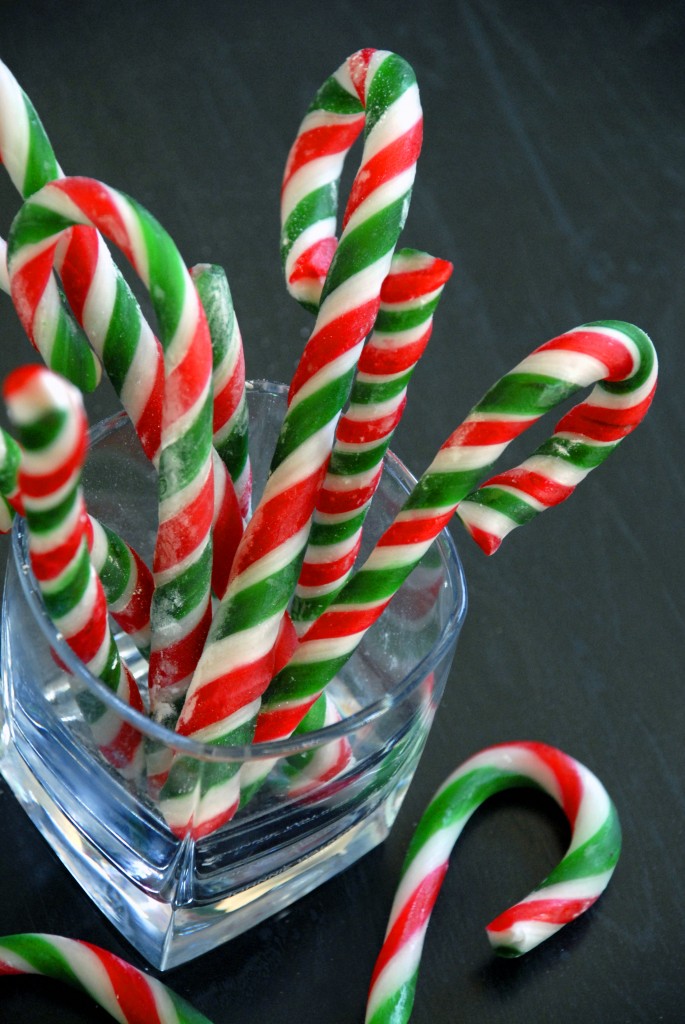
Whew, what a day-no sleep, no food, lots of running through the airport…it must mean Christmas travel! This is my first shot at the internet today, which is why this is such a late post, but I think it’s one worth waiting for. I mentioned I had a number of candy recipes for you and I’m going to go with the hardest first, candy canes, because these aren’t exactly something you want to try doing once the kids are in town (tomorrow’s recipe is definitely a more family-oriented one).
There are still sugar shards to be found around my kitchen and my hands ached the whole night after this project, but it was worth it just to be able to crunch into a pepperminty candy cane I made myself. I’m sure you’ll feel the same way!
Homemade Candy Canes
Adapted from Whirly Bird
- 3 cups sugar
- 1 teaspoon Peppermint flavoring (add 1/2 teaspoon more for stronger flavoring)
- 1/2 cup water
- 3/4 cup light corn syrup
- 1/2 teaspoon of food coloring for each color you want to twist in to the cane
- 1/4 teaspoon cream of tartar
- powdered sugar, for dusting
- vegetable oil, for greasing pans and utensils
- rimmed baking sheets, kitchen scissors, a candy thermometer, and at least one spatula (one spatula per color is better and I definitely found my wooden spatula to be the best to use by far)
Do set out all of your ingredients ahead of time so that everything will be ready to go. I can tell you now that it will take you a little while to get the technique down -I spent a lot of time putting the sugar in the oven to soften it and taking it back out to cool before I finally got a hang for how the sugar should feel in consistency and could actually start rolling it out into canes. The boyfriend would be very unhappy if I got sugar syrup all over his camera, so please do refer to Whirly Bird‘s post for pictures on what the process should look like at different stages. Good luck!
- Preheat oven to 350 degrees in case you need to soften the sugar back up during the process. Oil the baking sheets so they’re ready when your sugar reaches the right temperature and, if you have the extra counter space, sprinkle powdered sugar on a surface for later.
- Combine sugar, water, syrup, and cream of tartar in a saucepan-don’t stir-and bring to a boil. Keep letting the pot boil until your candy thermometer reaches 280 degrees.
- Pour the sugar into pools on the greased pans-I poured a bigger amount into one pan for the white and then in opposite corners of a second pan, poured two smaller amounts (one for green and one for red) making sure they didn’t run together.
- Pour the peppermint oil evenly over the different sugar pools, then pour the food coloring on to their respective small sugar pools. If you want white, leave that pool clear of dye.
- Let the sugar cool for a few minutes, then take a spatula and start to fold it over itself, as if you were kneading bread. The sugar should be cool enough that it should have a consistency almost like clay. If it’s just a sticky mess, let it cool for a little longer before kneading it. Once you knead it with a spatula enough that you can pick it up and mold it, pick up the sugar intended to be white and stretch, pull, and knead it with your hands. The longer you do this, you’ll see the white color come out. Roll the white sugar into a long log. Repeat with the colored sugars, but don’t knead these in your hand for too long or else white will get worked into your color and make pastels. Roll these into separate sugar logs as well.
- Press the smaller logs into the sides of the larger log (I put the red and green logs exactly opposite of each other on either side of the white log).
- Working quickly while the candy is still warm, take hold of one end of the log and start twisting the ropes together (oiling your hands lightly may make this process easier). The technique takes a second or two to get used to, but as you’re twisting the candy, pull it away from the rest of the candy log at the same time as you’re twisting so that it forms slender twisted rods. When you’ve reached your desired length, use scissors to snip the thin candy strip off the log, gently (GENTLY!) bend it into a hook shape, and place it on that surface you covered with powdered sugar.
- Repeat until you’ve used up the whole sugar log and your hands are bright red and angry at you. If the sugar cools too much during the process, I just kept the oven door open and held the log inside for a few seconds until it softened-you could see the skinner side start to droop. (I felt very much like a glass blower through this part)
- Let the candy canes “cure” overnight or else they’ll stick to your teeth-I hate when candy canes do this! Mine were still sticky to the touch the next day so I dusted them with powdered sugar all over and used a pastry brush to brush the excess off.
- Share with family and revel in your first step towards major hard candy making!



0 comments :